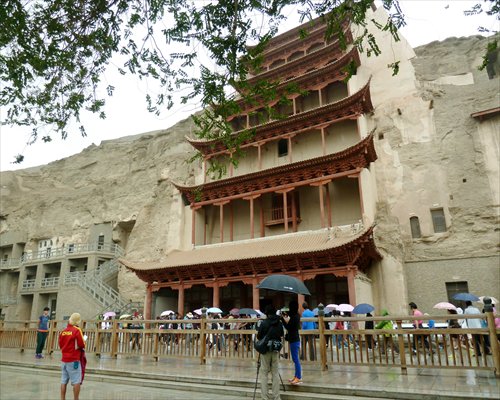Escaping the ravages of time

Listed as a World Cultural Heritage in 1978, Mogao Grottoes in Dunhuang of northwestern Gansu Province is well-known for its exquisite murals and statues. Dunhuang served as an important link on the historic Silk Road, the overland trade route that also paved the way for cultural exchanges between ancient China and the West.
For two millennia, the Mogao Grottoes has functioned like a treasure house of ancient domestic and exotic culture, particularly with regard to preserving some of the first Buddhist artifacts brought to China. These treasures are amply displayed within the grottoes 735 caves, in which there are 2,415 clay sculptures and some 45,000 square meters of murals.
While holding so many valuable historical relics, Mogao Grottoes is also facing inevitable damage from both nature and human activities. For years, the site has attracted numerous tourists from both home and abroad. And during the peak season, visitor numbers range from 4,000 to 7,000 even though the optimal capacity is only 3,000 per day.
A great deal of research has already been done to figure out the best ways to preserve the historic site. As a result, new technologies have been developed and are now being used by experts, and not only at the Mogao Grottoes, but at other Chinese cultural relics as well.
Staving off destruction
"We are dedicating our life to fighting against destruction of this site, to extend the life of the Mogao Grottoes," said Chen Gangquan, vice president of the protection research institute at the Dunhuang Academy (DHA).
To stave off destruction, Mogao Grottoes now only opens to the public around 60 of its more than 400 grottoes that contain murals.
For example, the murals and statues in the grottoes are mostly made of clay, wood and ryegrasses, which all easily decompose when exposed. Meanwhile, the large amount of carbon dioxide brought in by tourists increases the humidity and temperature inside the grottoes, leading to the corrosion of the murals.
According to Chen, without proper protection measures, pieces of those murals just fall off like bread crumbs. "Like the salt damage, it is one of the most serious and stubborn types of damage caused by natural factors," Chen said to Science and Technology Daily in May this year.
The soluble salts that commonly afflict murals are made of chloride and sulfate. In the past, we protected murals by applying a cement-like material that would penetrate the surface and hold the pieces together. But as time goes on, the soluble salt penetrated the protective barrier and caused even greater damage.
"It's been proved that the old method can only temporarily protect the relics; new damage will appear after a while," said Chen.
Now the DHA has co-developed a new desalting technology that uses a specially designed tissue that is applied to the surface of the murals to lower the salinity. "This method has a minor influence on the murals but offers good protection from the salt damage," said Chen.
Latest methods
Besides the desalting methods, other new technologies specific to various types of mural damage like flaking, crisping, hollowing and blowing have been developed for the protection of the Mogao Grottoes and other cultural relics.
According to an announcement by Gansu Provincial Science and Technology Department on November 7, after 10 years of research, a few new protection technologies co-developed by DHA and several famous international protection institutions including Australia Heritage Commission and Osaka University in Japan, have been approved by China's Ministry of Science and Technology, and officially put into practice.
"Those technologies are not just applied to the grottoes alongside the Silk Road, but to those ancient murals in other areas like Shanxi and Hebei provinces, and the Inner Mongolia Autonomous Region," said Zheng Huaping, deputy director of the provincial science and technology department.
Meanwhile other ancient-site-reinforcing technologies like strengthening by struts, surface weathering prevention, anchoring and grouting, have also been developed and used in the grottoes in Gansu and Xinjiang, as well as at non-grotto cultural sites like the Great Wall.
"These technologies will also go abroad in the future, helping the ancient murals in other countries like Egypt, India and Malaysia to preserve their historic sites," said Zheng.
Digital preservation
While new technologies may extend the life of an ancient site that has withstood the ravages of time for thousands of years, how to accurately and permanently preserve the murals and statues of the grottoes in a digital way is becoming a reality.
For example, a camera with a resolution of 1 billion pixels has been developed and put into use at Mogao Grottoes. It can collect the image of a 9-sqaure-meter mural within 20 minutes. Also a 3D laser scanner can copy the actual size of the relics. This technology has already been applied to the murals, ancient buildings, grottoes and relics in museums.
In 2010, the Inner Mongolia Museum used 3D laser technology to scan a colored coffin from the Liao Dynasty (916-1125). The coffin is a multilayer object with opulent adornments including 99 small bells. After scanning, even some barely visible textures at the pedestal of the coffin are made clear on a large screen.
The technology enables tourists to observe every detail of the relics without directly touching them and causing further damage.
For those tourists who are delighted by digital detail, a 260-million-yuan ($41.7 million) tourist service center that began construction in April 2010 is now near completion.
According to Luo Huaqing, vice president of DHA, the service center will begin welcome visitors in 2013, and will feature a digital film to show the history, culture and art of Dunhuang's cultural heritage.
"[The digital service center] will not only offer a diverse way for tourists to appreciate the ancient culture, but will also greatly alleviate the high pressure brought about by too many tourists during the peak season," Luo stressed during an interview with China News Service.